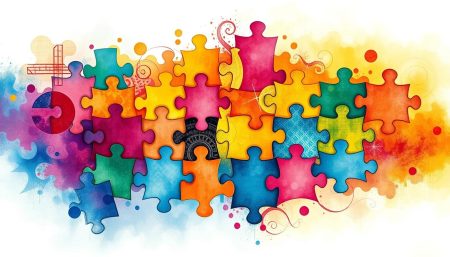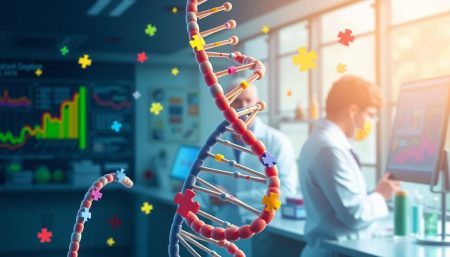The journey to understand autism spectrum disorder has been long and filled with research. Chapter 4 is key to unlocking the mysteries of ASD. It helps readers get a deep look into the condition. Knowing about ASD is vital for doctors, teachers, families, and those with autism.
Chapter 4 aims to clear up common misconceptions about autism. It shows autism as a complex spectrum with different challenges. This chapter goes beyond simple definitions, aiming for a deeper understanding.
As we explore this chapter, we dive into the heart of ASD. We learn about its traits and how it affects daily life. This is the start of our journey into understanding autism better.
This chapter is the foundation for the rest of the book. We will look at early diagnosis, behavior strategies, and education. It’s important to understand autism well to build a supportive society.
Introduction to Autism Spectrum Disorder (ASD)
Autism Spectrum Disorder (ASD) is a complex neurodevelopmental disorder. It shows in different symptoms and behaviors. These can change a lot from one person to another. Knowing about ASD helps in early and correct ASD diagnosis. It also improves support for people on the spectrum of autism.
Defining ASD in the Context of Neurodevelopmental Disorders
The Centers for Disease Control and Prevention (CDC) says ASD is a developmental disability. It’s because of brain differences. People with ASD often have trouble with social communication and interaction. They might also have limited or repetitive behaviors or interests.
The Range of Autism Spectrum Disorders
Autism Speaks explains how wide ASD is. It says ASD includes what were once seen as different conditions. These are autistic disorder, pervasive developmental disorder not specified (PDD-NOS), and Asperger syndrome. All are now part of the autism spectrum.
This shows how important it is to have treatments that fit each person’s needs. Every individual is different, and their therapy should reflect that.
| Previous Classification | Current Classification under ASD |
|---|---|
| Autistic Disorder | Autism Spectrum Disorder |
| Pervasive Developmental Disorder – Not Specified (PDD-NOS) | Autism Spectrum Disorder |
| Asperger Syndrome | Autism Spectrum Disorder |
Chapter 4. Autism Spectrum Disorder
In Chapter 4, we explore Autism Spectrum Disorder (ASD) deeply. We mix old insights with new rules to tell a complete story. This chapter is key for raising autism awareness and helps us understand ASD’s effects on people and society.
We start with a quick history of autism recognition and how it’s diagnosed today. We show how our views have changed, leading to today’s understanding and acceptance. Then, we dive into the current diagnostic standards, showing how they help identify and support ASD individuals.
A big part of Chapter 4 is a table that shows how our views of ASD have changed. It highlights important moments that have helped us better understand and accept autism today. This table helps us see the big differences and think deeply about ASD.
| Year | Perception/Understanding | Diagnostic Criteria |
|---|---|---|
| 1940s | Initial recognition, viewed as a form of schizophrenia | Non-specific, highly generalized |
| 1980s | Shift to developmental disorder classification | Introduction of specific criteria in DSM-III |
| 2000s | Growth in autism awareness, broader acceptance | Refined criteria in DSM-IV-TR, spectrum concept introduced |
| 2020s | Global awareness, integration into public health agendas | Detailed, nuanced criteria in DSM-5, support for early diagnosis |
This chapter gives a clear view of ASD’s diagnosis and adds personal stories and case studies. These stories show what life is like for those with autism. The goal is to give readers the knowledge to support and advocate for the autism community, going beyond just understanding to action and support in autism awareness.
The Importance of Early Diagnosis and Intervention
Understanding the role of early diagnosis of ASD and early intervention for autism is key. It can greatly change a child’s development. Finding ASD signs and symptoms early helps start treatment right away. This can lead to big gains in development.
Signs and Symptoms of ASD in Early Childhood
Finding ASD signs and symptoms in young children is hard but very important. The American Academy of Pediatrics suggests screening for ASD at 18 and 24 months. This helps catch early signs like not making eye contact, slow speech, and repeating actions.
Early Intervention for Autism: Strategies and Outcomes
The National Institute of Mental Health (NIMH) says early intervention for autism is very beneficial. It helps with learning, talking, and social skills. Effective methods include behavioral therapy, speech therapy, and help for parents, leading to better results.
| Age | Signs of ASD | Recommended Intervention |
|---|---|---|
| 18 months | Poor eye contact, no single words | Start of behavioral interventions |
| 24 months | Minimal interactive gestures, parallel play | Enhanced communication therapy |
| 30 months | Delayed speech, repetitive movements | Intensive personalized therapies |
The value of early intervention based on early diagnosis of ASD is huge. It can change a child’s path and improve their life a lot.
Overview of Cognitive Functioning in Autism
Looking into cognitive functioning in ASD shows a wide range of skills and challenges. People with autism can have anything from significant intellectual disabilities to very high cognitive abilities. They may have different strengths in problem-solving, learning speed, and adapting to new situations.
Some autistic individuals have amazing skills in areas like memory or music, known as ‘splinter skills’. These special talents can sometimes hide the challenges they face in other areas. This makes learning and growing up very complex.
- Identifying each person’s cognitive profile in autism.
- Creating learning strategies based on these profiles.
- Using technology to help with cognitive functions.
It’s key to understand and support each person’s unique needs. Tailored educational plans are vital. They help create a supportive learning space that values both strengths and challenges in cognitive functioning in ASD.
| Cognitive Area | Common Challenges | Notable Abilities |
|---|---|---|
| Problem-Solving | Difficulty with complex multi-step tasks | Excellent with patterns and puzzles |
| Memory | Short-term memory limitations | Long-term memory strengths in specific interests |
| Adaptive Behavior | Struggles with social cues | Highly focused on specific routines |
Understanding and supporting autistic cognitive abilities can greatly improve life and independence for those with autism. It shows how important it is to have personalized cognitive assessments and interventions.
Characteristics of Social Communication in ASD
Understanding social communication skills in ASD is key. It helps us support those with this condition. Knowing the challenges and strategies is vital for better interactions.
Developing Social Skills in Children with Autism
Teaching social communication skills is essential in ASD therapy and education. Structured environments with clear routines help. Play-based learning and social stories also improve social interaction.
Challenges in Verbal and Non-Verbal Communication
Children with ASD face challenges in verbal and non-verbal communication. It’s important to understand these challenges. They may struggle with tone of voice, facial expressions, and body language. Dedicated teaching and learning techniques are needed.
| Communication Aspect | Common Challenges | Strategies for Improvement |
|---|---|---|
| Verbal Skills | Limited vocabulary, echolalia | Speech therapy, interactive language games |
| Non-Verbal Skills | Poor eye contact, difficulty reading body language | Social stories, role-playing exercises |
| Social Cues | Misinterpretations of gestures, proxemics issues | Behavior modeling, visual aids |
Understanding Sensory Processing Issues in Individuals with ASD
Sensory processing in autism is complex and affects daily life. Understanding sensory sensitivities in ASD helps caregivers and educators. They can then adjust environments and interactions to meet individual needs.
Identifying Sensory Sensitivities and Preferences
Sensory sensitivities in ASD can show up in many ways. This includes being overwhelmed by sounds and lights, or having trouble with touch. To start, families and professionals need to watch closely and talk about what they see.
They must find out what triggers these sensitivities and what each person prefers. This helps create a supportive sensory environment.
Integrating Sensory-Smart Strategies into Daily Life
Adding sensory integration strategies to daily routines is key for those with autism. It helps them connect better with their surroundings. This can include sensory rooms, special clothes, and breaks to manage too much stimulation.
Good sensory integration strategies can cut down on sensory overload. This can lead to better focus, communication, and emotional health.
- Visual supports to communicate schedules and expectations clearly.
- Tactile tools like stress balls or fidget spinners to provide calming sensory input.
- Auditory adjustments such as noise-cancelling headphones to manage sound sensitivities.
By tackling sensory sensitivities in ASD, parents and professionals help in the development and better sensory experiences for those with autism.
Exploring Behavior Management in Autism
Managing behavioral challenges in ASD is key for learning and social skills. Using the right behavior management techniques can greatly improve life for those with autism. This part looks at these methods and how they work.
Applied Behavior Analysis (ABA) is a well-known method for handling behavioral challenges in ASD. It aims to cut down on bad behaviors and boost good ones by using rewards. ABA’s success makes it a vital part of behavior management techniques.
Other important strategies include structured learning spaces, set schedules, and visual aids. These tools help reduce anxiety and stress, which often lead to tough behaviors. This makes it easier to manage emotions and behaviors.
| Technique | Objective | Outcome |
|---|---|---|
| Applied Behavior Analysis (ABA) | Reduce problematic behaviors | Increase in desired behaviors |
| Structured Learning | Enhance predictability and security | Improved engagement and focus |
| Visual Aids | Clarify expectations and routines | Reduction in confusion and anxiety |
To learn more about these methods in autism, check out the difference between autism and mental health. This resource offers deep insights into autism and its behaviors.
- Positive Reinforcement
- Consistency in Behavior Expectations
- Parent and Teacher Collaboration
In summary, using these behavior management techniques and knowing about behavioral challenges in ASD helps create a better environment for those with autism.
Evaluating Educational Strategies for ASD
Getting the right education is key for kids with Autism Spectrum Disorder (ASD). By using the best educational strategies, teachers and caregivers can make learning better for everyone. This helps students do well in school and get along with others.
Inclusive Education Models for Children with Autism
Inclusive education means kids with autism learn in regular classrooms. Groups like the Council for Exceptional Children support this idea. It helps kids with autism talk more and get along with others, creating a friendly classroom.
Customized Learning Approaches for Special Needs
Learning should fit each child’s needs, not just one way. Studies show that programs made just for each student work best. These programs make sure every child learns in the way that works best for them.
| Feature | Standard Education Model | Adaptive Educational Model |
|---|---|---|
| Approach to Learning | One-size-fits-all | Customized based on student needs |
| Curriculum Flexibility | Fixed curriculum | Flexible, adjustable curriculum |
| Assessment Methods | Uniform assessment standards | Personalized, continuous assessment |
| Student Engagement | Varies, often low in special needs students | Highly engaged through tailored activities |
| Outcome | Standard academic achievements | Enhanced learning outcomes, personal growth |
Learning about and using these strategies can really help students with ASD. It makes sure they get the education they need to thrive.
The Neurological Underpinnings of ASD
Exploring the neurological basis of ASD gives us deep insights. It shows how the brains of those with autism differ from others. This knowledge is key for better understanding and helping those with autism.
Scientists look at brain activity and structure to find out what sets ASD apart. Their work is vital for creating treatments that really work for people with autism.
- Studies often find brain size and connection differences in people with ASD.
- How the brain handles information can also affect symptoms.
- Research into genes and environment is ongoing in autism brain science.
Knowing about the neurological basis of ASD helps make treatments more effective. It also gives families and teachers the tools they need. Thanks to new research, we’re learning more about autism every day.
The Role of Genetics in Autism Spectrum Disorder
Looking into genetics in autism spectrum disorder shows how genes and environment work together. This mix greatly affects how ASD develops. It also opens up new paths for research and treatments.
Understanding the Hereditary Aspect of Autism
Studies in top journals like Nature Genetics have found many genes linked to ASD risk. These genes help explain why some families are more likely to have autism.
Recent Discoveries in Autism Genetics
New research has uncovered how certain genes can affect autism’s likelihood and severity. These breakthroughs are key for creating better treatments. They also change how we care for and help people with autism.

Agencies like the Centers for Disease Control and Prevention (CDC) talk about the role of genes and environment in autism. Their ongoing studies show we need a detailed look at genetics in autism spectrum disorder.
This mix of genetic knowledge and ongoing research helps us understand ASD better. It also leads to more effective ways to manage autism in different groups.
Addressing Myths and Misconceptions About Autism
When we talk about myths about autism and ASD misconceptions, it’s key to clear up common lies. These lies can hurt and confuse people with autism spectrum disorder. We aim to fix these myths with solid facts.
ASD misconceptions often come from not knowing the real deal about autism. A big myth is that everyone with autism is the same. But, each person is different, with their own strengths and challenges. By fighting these myths, we help make our world more welcoming and understanding.
| Myth | Fact |
|---|---|
| Autism is caused by poor parenting. | Autism is a neurodevelopmental disorder with genetic and environmental influences, not caused by parenting styles. |
| People with autism do not have emotions. | Individuals with autism can experience a wide range of emotions but might express them differently than others. |
| Autism can be cured. | There is no cure for autism, but various therapies and interventions can help individuals manage challenges and lead fulfilling lives. |
Understanding and debunking myths about autism really matters. It affects how much support and chances people with autism get. By choosing facts over fiction, we help everyone with ASD fit in better in our society.
The Impact of ASD on Family Dynamics
Autism Spectrum Disorder (ASD) brings big changes to families. It changes how parents act and affects siblings in special ways. This creates unique family dynamics.
Supporting Siblings of Children with Autism
Siblings of kids with autism face many challenges. They deal with emotional, social, and psychological issues. Groups like The Autism Society stress the need for support and understanding for them.
This support helps siblings deal with their feelings. It makes the family environment more supportive.
Navigating the Emotional Challenges for Parents
Parents of kids with autism face huge emotional challenges. Autism Speaks helps parents share their experiences. This shows the emotional struggles and strength needed to care for a child with autism.
These stories are key in building a supportive community. They help parents manage stress and set realistic expectations.
| Issue | Impact | Support Strategies |
|---|---|---|
| Parental Stress | High | Counseling, Community Support Groups |
| Sibling Adjustment | Variable | Family Therapy, Sibling Support Programs |
| Family Roles | Shifting | Family Meetings, Adaptive Role Assignments |
Transitioning to Adulthood with Autism Spectrum Disorder
The move from childhood to adulthood is tough, even more so for those with ASD. This time needs careful planning and strong support to help them adjust. It’s important to focus on continuing education, finding jobs, and learning to live independently.
Start planning for adulthood with ASD early, like in the teenage years. This helps prepare for the future. It’s key to have a team of educators, therapists, and career advisors who know about autism in adults. They should make plans that fit each person’s needs and goals.
- Continuation of Education: Look for educational options that meet the needs of adults with autism. This could be special training programs or inclusive colleges.
- Employment: Help find jobs that match a person’s skills and interests. This includes vocational training and job placement services.
- Independent Living: Learning to manage daily tasks, take care of oneself, and handle money is vital for living on one’s own.
| Focus Area | Strategy | Objective |
|---|---|---|
| Education | Inclusive academic settings | Enhance learning adaptability |
| Employment | Job training workshops | Secure suitable employment |
| Independence | Life skills coaching | Achieve daily living autonomy |
It’s important for communities to offer resources and support for adults with autism. Organizations and support groups are key. They provide ongoing help and information that helps adults with autism succeed.
The success of transitioning to adulthood with ASD relies on early planning, ongoing support, and access to tailored resources. This ensures a smooth transition for those living with autism as adults.
Advancements in Autism Research and Future Directions
The advancements in autism research have led to big steps forward in understanding and treating Autism Spectrum Disorder (ASD). The use of technology in autism support has opened new ways to improve therapy. This is a big step towards a better future of ASD treatment.
Current Trends in Autism Spectrum Disorder Research
Research on autism is growing, focusing on what causes it. The Autism Research Institute is leading studies on new treatments. These efforts are key to understanding autism better, including its many forms.
The Role of Technology and Innovation in Autism Support
Recent studies show how technology, like virtual reality, is changing autism support. Virtual reality helps practice social skills in a safe space. This can improve how people with autism interact with others.
- Personalized Learning Tools: Software and apps adjust to each learner’s needs, making learning easier for those with autism.
- Communication Aids: Devices and apps help those who can’t speak well or at all to communicate better.
- Behavioral Analytics: New software predicts behavior and offers ways to handle it before it happens.
The mix of technology in autism support and ongoing advancements in autism research is creating a bright future of ASD treatment. These technologies support current needs and grow as our understanding of autism improves.
Legal Rights and Advocacy for Individuals with ASD
In the United States, people with autism have many legal rights for autism. These rights protect them in education, healthcare, and work. Laws like the Individuals with Disabilities Education Act (IDEA) help kids with ASD get the education they need. The Americans with Disabilities Act (ADA) gives them rights in work and public places too.
But, having rights on paper isn’t enough. Autism advocacy groups work hard to make these rights real. They help those who can’t speak for themselves. They teach and empower everyone, from families to lawmakers, to make society more welcoming.
Self-advocacy is also growing in the autism community. People with autism are now sharing their dreams, struggles, and views. This shift helps everyone understand autism better. It shows that people with ASD are not just recipients of rights but also leaders in making things better.
FAQ
Q: What is Autism Spectrum Disorder?
A: Autism Spectrum Disorder (ASD) is a condition that affects how people interact and communicate. It also involves repetitive behaviors or interests. It includes different conditions like autistic disorder and Asperger syndrome.
Q: Why is early diagnosis and intervention for ASD important?
A: Early diagnosis and intervention are key for ASD. They help a child develop better. Early help can improve communication, social skills, and learning.
Q: How does cognitive functioning vary in individuals with ASD?
A: People with ASD have different levels of intelligence. Some have intellectual disabilities, while others are average or even above average. They often struggle with executive functions but can excel in certain areas.
Q: What are some of the challenges in social communication for individuals with ASD?
A: Those with ASD may find it hard to understand and use social cues. They struggle with conversations and forming relationships. This can make social interactions difficult.
Q: What are sensory processing issues, and how do they affect individuals with ASD?
A: Sensory processing issues mean some people with ASD are too sensitive or not sensitive enough to sounds, lights, and touch. This can cause discomfort and affect their daily lives.
Q: What behavior management strategies are effective for children with ASD?
A: Effective strategies include Applied Behavior Analysis (ABA) and Positive Behavior Support (PBS). These methods teach new skills and reduce problem behaviors by changing the environment and using rewards.
Q: Why are educational strategies specialized for ASD important?
A: Specialized education is vital for ASD. It meets the unique learning needs of individuals with autism. This includes structured teaching and visual aids.
Q: Can you explain the neurological basis of ASD?
A: ASD is linked to differences in brain structure and function. Studies show changes in areas related to social skills and communication. But, the exact causes are not fully understood yet.
Q: What role does genetics play in ASD?
A: Genetics play a big part in ASD. Many genes and variants increase the risk. But, how these genes work and interact with the environment is complex.
Q: How can misconceptions about ASD be addressed?
A: Misconceptions about ASD can be corrected with accurate information and education. Advocacy and sharing personal experiences help dispel myths and raise awareness.
Q: What impact does ASD have on family dynamics?
A: ASD affects families in many ways. It brings emotional and practical challenges for parents. Siblings also need support and understanding.
Q: What are the challenges associated with transitioning to adulthood for individuals with ASD?
A: Transitioning to adulthood for those with ASD is challenging. They face issues like finding jobs, making friends, and living independently. They need ongoing support and accommodations.
Q: What are some current advancements in autism research?
A: Research is making progress in ASD. This includes genetic studies, new behavioral interventions, and technology like virtual reality. These advancements aim to improve support and understanding for individuals with ASD.
Q: What legal rights and advocacy exist for individuals with ASD?
A: People with ASD have legal rights in education, healthcare, and work. Laws like the IDEA and ADA protect these rights. Advocacy groups work to ensure these rights are respected and understood.


















